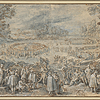The Power of Iconic Memory: Iconoclasm as a Mental Marker
DOI:
https://doi.org/10.18352/bmgn-lchr.10183Keywords:
Iconoclastic Fury, Iconoclasm, History, Low Countries, BelgiumAbstract
Iconoclasm has a particular effect in that it creates an image that is even more powerful than the image it has destroyed. While many physical images might have disappeared due to the iconoclasm, the mental image of all who witnessed this dramatic moment in history was indelible. This article argues that artists made conscious use of the emotional and cognitive power of such mental images to give their work meaning.
This article is part of the special issue 'Beeldenstorm'.
De kracht van iconisch geheugen. Iconoclasme als een mentale markering
Iconoclasme heeft het bijzondere effect dat het een beeld creëert dat nog sterker is dan het beeld dat het vernielt. De vele fysieke beelden mogen dan al verdwenen zijn door de Beeldenstorm, het mentale beeld werd een onuitwisbare herinnering aan een ingrijpend moment in de geschiedenis voor iedereen die er getuige van was. In dit artikel wordt beargumenteerd dat kunstenaars bewust gebruik maakten van de emotionele en cognitieve kracht van dit mentale beeld om hun werk betekenis te geven.
Dit artikel maakt deel uit van het themanummer 'Beeldenstorm'.
Downloads

Published
Issue
Section
License
Authors who publish with this journal agree to the following terms:
a) Authors retain copyright and grant the journal right of first publication with the work simultaneously licensed under a Creative Commons Attribution 4.0 International (CC BY 4.0) that allows others to share the work with an acknowledgement of the work's authorship and initial publication in this journal.
b) Authors are able to enter into separate, additional contractual arrangements for the non-exclusive distribution of the journal's published version of the work (e.g., post it to an institutional repository or publish it in a book), with an acknowledgement of its initial publication in this journal.
c) Authors are permitted to post their work online (e.g., in institutional repositories or on their website) prior to and during the submission process.
Authors are explicitly encouraged to deposit their published article in their institutional repository.







